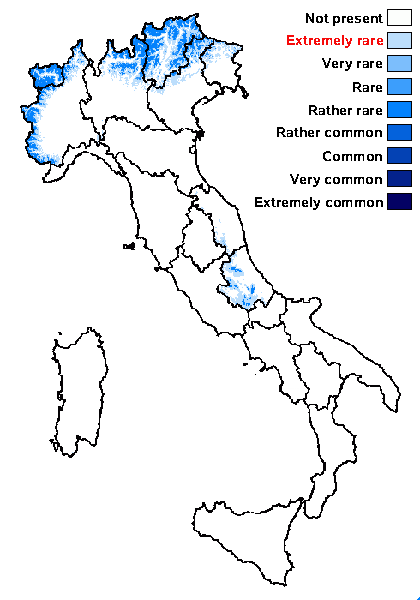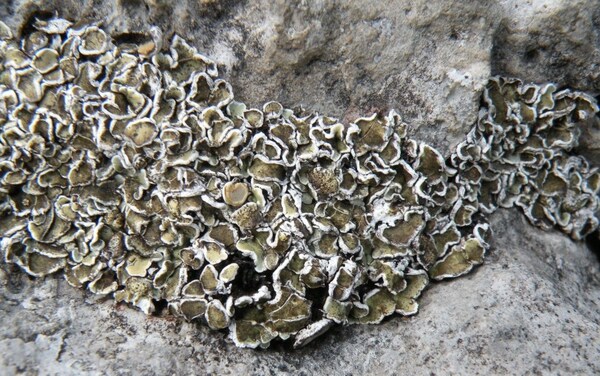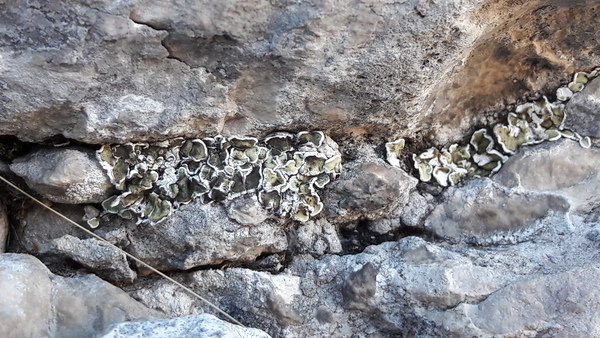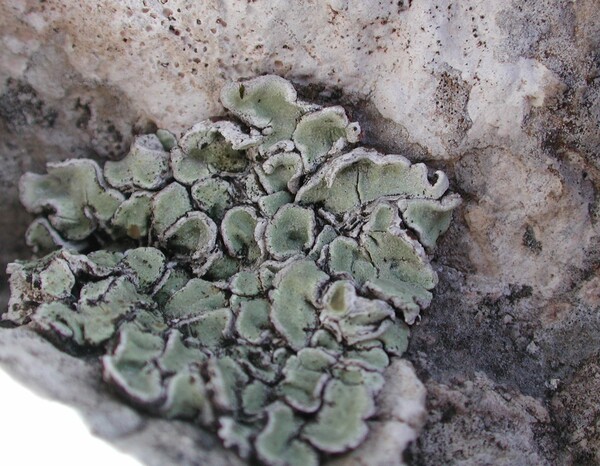Squamarina subcetrarioides (Zahlbr.) Y.Y. Zhang
in Zhang & al., Lichenologist, 55: 135, 2023. Basionym: Lecanora fragilis Zahlbr. var. subcetrarioides Zahlbr. - Ann. naturhist. Mus. Wien, 38; 143, 1925
Synonyms: Squamarina gypsacea var. subcetrarioides (Zahlbr.) Pišút
Distribution: N - Frl (Tretiach & Molaro 2007, Ravera & al. 2023b), Ven (Caniglia & al. 1999, Nascimbene & Caniglia 2003c, Nascimbene 2005c, 2008c, Thor & Nascimbene 2007, Giovagnoli & Tasinazzo 2014, Ravera & al. 2023b), TAA (Nascimbene & al. 2006, 2022, Nascimbene 2008b, Ravera & al. 2023b), Lomb (Dalle Vedove & al. 2004, Gheza 2019), Piem (Isocrono & al. 2004, Ravera & al. 2023b, Ravera & al. 2023b), VA (Piervittori & Isocrono 1999). C - Marc (Nimis & Tretiach 1999, Ravera & al. 2023b), Abr (Ravera & al. 2023b).
Description: Thallus squamulose to crustose-placodioid, greenish, initially forming 2-7 cm wide, well-delimited rosettes which are continuous and usually epruinose in central parts, deeply and frequently lobed in peripheral parts, the margin of lobes strongly white-pruinose; mature thalli irregular in outline, becoming transversely cracked, with numerous small, white-rimmed, dissected squamules. Lower surface white to pale brown, with scattered, dark brown to black, simple, fragile hapters. Upper cortex 45-55 μm thick, inspersed with pale brown granules dissolving in K, overlain by a thin epinecral layer; medulla white, thick, filled with calcium oxalate crystals; lower cortex absent. Apothecia lecanorine, common only in the mature, more squamulose thalli, scattered, rounded, 2-6 mm across, with a pale ochraceous, faintly white-pruinose, slightly concave disc, and an entire, partly pruinose, usually persistent thalline margin. Cortex of thalline margin similar to the upper cortex of thallus; epithecium 10-17 μm high, with pale brown granules dissolving in K and calcium oxalate crystals; hymenium colourless, 75-85 μm high, with pale brown granules dissolving in K; paraphyses simple, c. 2 μm thick; subhymenium 20-27 μm high, with clusters of calcium oxalate crystals; hypothecium 150-200 μm high, with pale brown granules dissolving in K, not subtended by an algal layer. Asci 8-spored, clavate to cylindrical-clavate, the apical dome K/I+ dark blue, the wall I-, but the thin outer gel I+ blue, Bacidia-type, 57-75 x 10-15 μm. Ascospores 1-celled, hyaline, subfusiform to ellipsoid, 11-17 x 5-7 μm. Photobiont chlorococcoid. Spot tests: cortex K-, C-, KC- or KC+ yellowish, P-, UV-; medulla P+ yellow. Chemistry: cortex with isousnic and usnic acid, medulla with psoromic and 2ʹ-O-demethylpsoromic acids.Note: for a long time considered just as a form of S. gypsacea, this species differs in morphology, ecology and molecular data (see Zhang & al. 2023). It grows on often fissured calcareous rocks, with optimum above treeline, and is known from the Alps and the Carpathians. Here, pending a thorough revision of all samples of S. gypsacea in the Italian herbaria, I have placed all records of this species from upland areas.
Growth form: Squamulose
Substrata: rocks
Photobiont: green algae other than Trentepohlia
Reproductive strategy: mainly sexual
Commonnes-rarity: (info)
Alpine belt: rather rare
Subalpine belt: rare
Oromediterranean belt: very rare
Montane belt: extremely rare
Submediterranean belt: absent
Padanian area: absent
Humid submediterranean belt: absent
Humid mediterranean belt: absent
Dry mediterranean belt: absent

Predictive model
Herbarium samples

Gabriele Gheza; Owner: Gabriele Gheza
Italy, Lombardia, Corna di San Fermo, nel gruppo del Pizzo Camino (ValCamonica).
Herbarium: Forum Natura Mediterraneo
2010
Growth form: Squamulose
Substrata: rocks
Photobiont: green algae other than Trentepohlia
Reproductive strategy: mainly sexual
Commonnes-rarity: (info)
Alpine belt: rather rare
Subalpine belt: rare
Oromediterranean belt: very rare
Montane belt: extremely rare
Submediterranean belt: absent
Padanian area: absent
Humid submediterranean belt: absent
Humid mediterranean belt: absent
Dry mediterranean belt: absent

Predictive model
| Herbarium samples |






